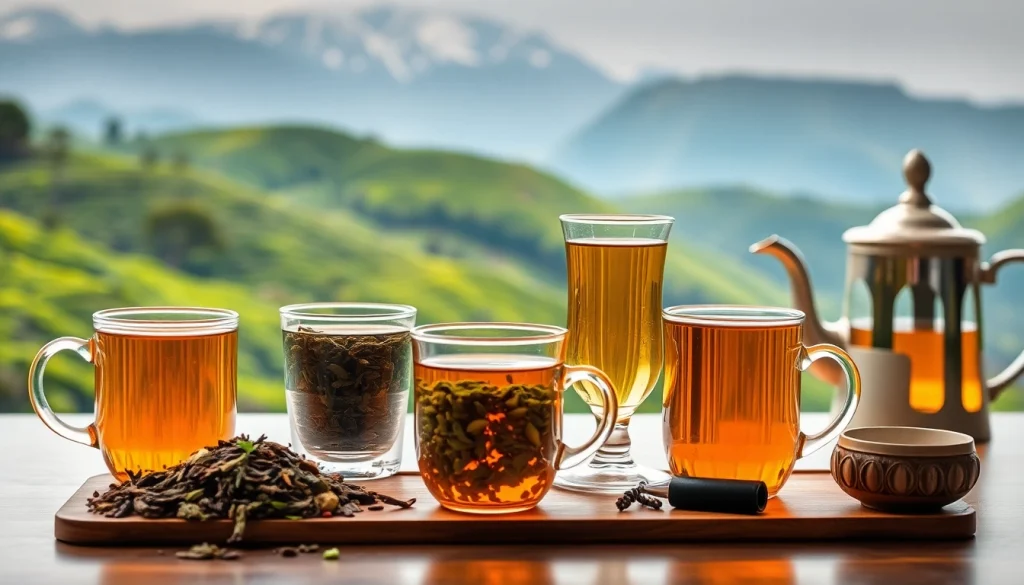Introduction to the Best Teas from Nepal
Nepal, a tiny Himalayan nation known for its majestic mountains, is equally celebrated for its rich and diverse tea culture. The country’s unique geography and climate provide an ideal environment for cultivating high-quality teas that have captured the hearts of tea lovers across the globe. Among these treasures are some of the best teas from Nepal, characterized by their distinctive flavors, aromas, and health benefits. This exploration into Nepali teas will delve into the unique taste profiles, historical significance, and health benefits associated with these brews.
The Unique Taste Profiles
Nepali teas are often compared to their more famous counterparts from Darjeeling, but they possess a unique flavor profile that sets them apart. The high-altitude environment of tea cultivation in Nepal contributes to this uniqueness. From the bright floral notes of high-quality green teas to the robust, malty characteristics of black teas, each tea type presents a small insight into the mountainous landscapes of this remarkable country.
For instance, the Himalayan Golden Black Tea is renowned for its golden-tipped leaves and an award-winning flavor that can be both sweet and floral. On the other end of the spectrum, the Jun Chiyabari Estate’s offerings are known for their complex, fruity profiles. The variety in taste profiles is largely due to the differing elevations, soil types, and climatic conditions found across various growing regions in Nepal.
Historical Significance of Nepali Tea
The history of tea in Nepal is interwoven with its agricultural development and cultural practices. Tea was introduced to Nepal by the British during the mid-19th century. The first commercial tea gardens were established in the Ilam district, where the climate and soil conditions were ideal for tea cultivation. Over the years, tea production has grown into a significant industry for the nation; it serves as a vital source of income for local communities.
Traditional drinks like Nepali milk tea, often spiced with cardamom and ginger, have roots deeply embedded in local customs. It is common to welcome guests with a cup of this tea, symbolizing hospitality—a practice that underscores the cultural importance of tea in Nepalese life.
Health Benefits of Drinking Nepali Teas
Drinking tea from Nepal is not just a delight for the senses; it also comes with a plethora of health benefits. Rich in antioxidants, Nepali teas can help reduce oxidative stress and lower the risk of chronic diseases. The polyphenols found in these teas have been linked to improved cardiovascular health, reduced cholesterol levels, and better digestive health.
Furthermore, the herbal teas from Nepal, such as those infused with lemongrass or turmeric, are known for their calming effects and promote relaxation, making them a popular choice for wellness enthusiasts. These natural elements not only make the teas flavorful but also enhance overall well-being, making them an essential addition to any health-conscious diet.
Understanding the Varieties of Nepali Teas
Black Teas from the Himalayas
Black tea is the most widely consumed type in Nepal, cherished for its robust flavors and energizing properties. The Kanchanjangha Tea Estate and the Ilam Tea Garden produce some of the finest black teas characterized by their malty and muscatel profiles, drawing comparisons to Darjeeling teas.
The processing method followed at these estates ensures that the leaves preserve their unique flavors. Workers handpick the leaves, which are then withered, rolled, oxidized, and dried—a meticulous process that enhances the tea’s aromatic qualities. The result is a cup of black tea that is rich, full-bodied, and satisfying.
Green Teas: A Refreshing Brew
Alongside black teas, Nepali green teas are gaining recognition for their refreshing taste and numerous health benefits. Green tea is typically less processed than black tea, retaining more of its natural antioxidants. The altitude at which these teas are grown contributes to their unique flavors, setting them apart from similar varieties found in other regions.
Notable among these is the organic green tea that offers a sweet aroma reminiscent of citrus fruits, providing a smooth drinking experience that pleases the palate. The vibrant green leaves not only look appealing but also encapsulate a taste that is both invigorating and delicate.
Herbal and Wellness Teas
Herbal teas are another noteworthy segment in the Nepali tea market, purposefully crafted using a combination of herbs, flowers, and spices. For example, teas infused with local herbs such as Tulsi (holy basil) and ginger are popular due to their medicinal properties.
These herbal concoctions are often consumed for their therapeutic benefits—ranging from aiding digestion to relieving headaches—making them a staple in many households. Such wellness teas highlight the connection between cultural practices and health in Nepalese society.
How to Brew and Enjoy Nepali Teas
Traditional Brewing Methods
The preparation of tea in Nepal varies by type and personal preference. Traditional brewing often involves using fresh filtered water heated to a specific temperature to avoid burning the delicate leaves. For black teas, bringing water to a rolling boil is necessary, while green and herbal teas require slightly cooler water to maintain the integrity of the flavors.
Generally, the steeping time can range from 3 to 5 minutes, depending on the tea type. The color and aroma of the brew will indicate readiness. Many locals prefer using traditional clay pots for their authenticity and ability to enhance the tea’s flavors.
Pairing Teas with Food
Pairing tea with food can elevate both your culinary and tasting experiences. Nepali black teas, with their robust flavors, pair well with hearty dishes such as momos or spicy curries. The bold notes of the tea can complement the richness of the food.
Conversely, lighter floral notes from green teas serve as a refreshing accompaniment to lighter fare such as salads or grilled vegetables. For herbal teas, pair them with fruits or light desserts to enhance the experience without overpowering the delicate flavors.
Tips for Enhancing Flavor
While Nepali teas are delightful on their own, there are several ways to enhance their flavors further. Adding a touch of honey or lemon can brighten the cup, while spices such as cinnamon or cardamom can add complexity. For green teas, a dash of mint can yield a refreshing twist.
Experimenting with temperature and steeping times can also uncover new flavor dimensions. Keeping notes on your preferred practices will help you refine your brewing method to suit your taste.
Where to Buy the Best Teas from Nepal
Top Online Retailers and Their Best Offerings
With the popularity of Nepali teas on the rise, numerous online retailers provide easy access to these exquisite products. Websites like Nepal Tea Traders showcase a variety of premium options, allowing customers to explore the best offerings from Nepal.
Additionally, specialized tea retailers often provide insights into the sourcing and story behind each tea, adding to the overall experience of exploring Nepali teas. Products like the Himalayan Golden Black Tea and unique herbal blends can found with a simple search.
Local Markets and Specialty Stores
For those living in areas with a substantial Nepali community, local markets may present an opportunity to discover fresh and authentic teas. Visiting these markets allows consumers to interact directly with vendors who can offer advice and recommendations based on individual preferences.
Specialty tea shops also frequently carry a selection of Nepali teas, often providing tastings and the opportunity to learn more about the tea’s origins and proper brewing methods.
Ethical Sourcing and Fair Trade Options
As consumers become more conscious about their purchasing decisions, the demand for ethically sourced and Fair Trade teas has surged. Many Nepali tea producers are committed to sustainable practices, ensuring that growers are fairly compensated while promoting environmental stewardship.
When shopping for Nepali teas, look for certifications that indicate ethical sourcing. This not only supports local economies but also contributes to preserving the rich cultural and agricultural heritage of Nepal.
Final Thoughts on the Best Teas from Nepal
The Cultural Importance of Tea in Nepal
Tea is integral to Nepalese culture, symbolizing hospitality and community. It plays a vital role in social gatherings, celebrations, and daily life. As you explore the best teas from Nepal, you participate in a tradition that has deep roots in the nation’s history and lifestyle.
Encouraging Sustainable Practices
As you embrace Nepali teas, consider the impact of your choices. Supporting local producers through ethical purchasing not only brings exquisite flavors into your home but also helps preserve the craft and tradition of tea cultivation in Nepal.
Your Next Steps in Tea Exploration
Embarking on a journey to discover the best teas from Nepal opens a world of flavors and cultural insights. From experimenting with various tea types to understanding their health benefits, there’s much to explore. Engage with local communities or online forums dedicated to tea aficionados, share your experiences, and deepen your appreciation for this remarkable beverage.





